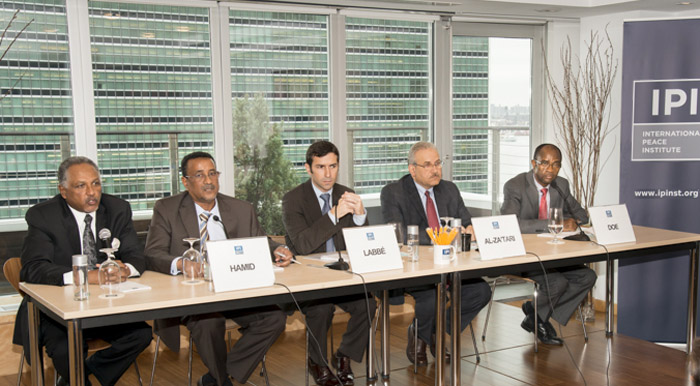
The International Peace Institute organized a discussion on October 10, 2013 that looked at how to strengthen the resilience of communities in Sudan to ensure that humanitarian assistance is more sustainable and to avoid the aid dependency trap.
Ten years after the beginning of the conflict in Darfur and more than $10 billion in humanitarian aid later, humanitarian needs in Sudan remain acute. Extreme climatic events, such as droughts and flash floods; chronic food insecurity in parts of the country; and conflict-related displacement, new and protracted, have all contributed to the humanitarian situation.
This discussion, which was part of IPI’s Humanitarian Affairs Series, brought together Ali Al-Za’tari, UN Humanitarian Coordinator for Sudan; Ibrahim Mahmoud Hamid, Minister of the Interior of the Republic of Sudan; and Samuel Doe, Senior Policy Advisor with the UN Development Programme’s Bureau for Crisis Prevention and Recovery.
The following insights emerged from the meeting:
1. For decades, the Sudanese people have developed positive resilience by bouncing back from a multiplicity of crises, but also negative resilience by coping from one catastrophe to the next. To strengthen the positive resilience of communities and go beyond addressing the symptoms of crises, the root causes of humanitarian needs should be addressed, including the persistent and protracted conflicts; institutional fragility and lack of capacity; and high levels of illiteracy.
2. The key to addressing the root causes is to empower national authorities, local institutions, and communities to be better prepared to respond to crises. In this respect, a nationally-led humanitarian response is desirable. However, it must also be acknowledged that national and local authorities do not always have the means or the ability to provide the required assistance. In such cases, Sudan has to accept the support and sometimes direct response of international agencies.
3. Access to areas that have pressing humanitarian needs such as South Kordofan and Blue Nile states has been a point of contention between international actors and the government of Sudan. However, there are indications from all stakeholders that they are prepared to work together to deliver aid, including humanitarian programs aimed at strengthening communities’ resilience.
4. While traditional humanitarian aid is still required to address acute needs in conflict-affected areas such as Darfur, South Kordofan, and Blue Nile, the most urgent needs are not limited to conflict-affected areas. For instance, the highest levels of malnutrition and the worst education indicators are in the east of the country. In particular where underdevelopment and lack of capacity are key drivers, these can be addressed in the longer term by strengthening the resilience of communities.
5. The United Nations is intent on better integrating its humanitarian and development assistance in Sudan, as indicated by the forthcoming joint visit of the heads of its humanitarian and development agencies. The UN country team plans to develop a joint, multiyear humanitarian strategy that will link up with the development assistance framework and ensure more predictable funding.







